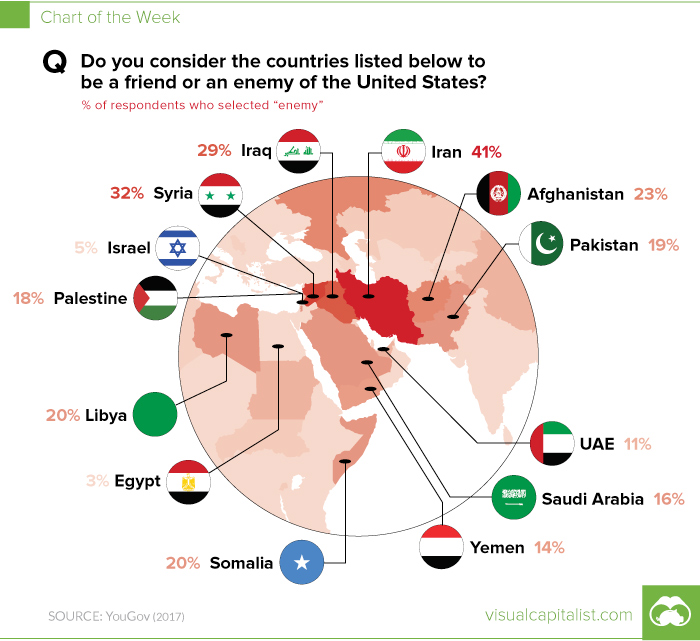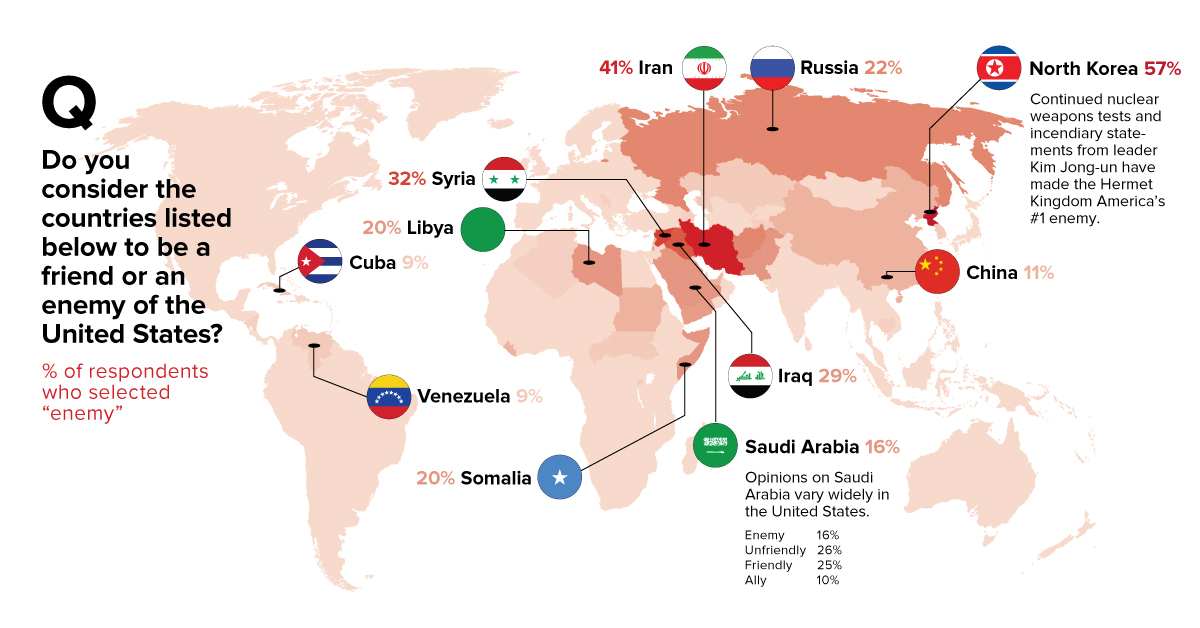Between alleged interference in U.S. elections by Russia, recent nuclear posturing by North Korea, and chemical weapon atrocities in Syria – it’s hard to keep track of which country is supposed to be the bona fide number one “enemy” of the United States. While we can’t tell you exactly what people are thinking in this moment, we do have access to about 15 years worth of polls on the subject. The data ends up painting an interesting backdrop for America’s foreign policy decisions over the same timeframe, as well as the narratives being pushed by major media outlets.
Congrats, Dear Leader
Today’s first map visualizes the most recent data from a YouGov survey between January 28 and February 1, 2017, which was taken just before the most recent string of geopolitical turmoil. During the survey window, more Americans viewed North Korea as an enemy than any other country, with the Hermit Kingdom being ranked as an “enemy” by 57% of respondents. Of course, new tensions have surfaced since then, as North Korea continues to defy U.S. pressure with further missile tests under Kim Jong-Un. This probably hasn’t helped their case with American citizens. As you might imagine, aside from North Korea, most of the countries that skew towards the top of the “enemy” spectrum are located in the Middle East and North Africa. Here’s a close-up of that region, with the numbers that specific countries poll at there:
Looking just at this geographic area, Iran stands out the most with 41% of Americans considering it to be an “enemy”. That places it right behind North Korea on the enemy list, at least as far as this most recent poll is concerned. Following Iran in the rankings were Syria (32%), Iraq (29%), and Afghanistan (23%).
Changing Enemies Over Time
One thing is for sure: America’s biggest foe isn’t a constant. The identity of America’s arch-nemesis ebbs and flows as global events unfold, and the opinions of citizens are swayed. The following animation shows the answer to a slightly different poll question, this time by Gallup, which was asked multiple years between 2001 and 2016. Specifically, Americans were asked (unprompted) to name the country that is their “greatest enemy”. See how the rankings fluctuate over time, including Iraq’s precipitous drop after Saddam was ousted and the country turned out to not have WMDs:
Particularly, Iran had a good run between 2006-2012, when it was the top-ranked “enemy” in each year a poll was done. At other times, North Korea (2005, 2016), Iraq (2001, 2005), Russia (2015), and China (2014) have all topped the list as well. on Even while political regimes across these countries have changed over time, they’ve largely followed a few different types of governance. Today, every country can ultimately be classified into just nine broad forms of government systems. This map by Truman Du uses information from Wikipedia to map the government systems that rule the world today.
Countries By Type of Government
It’s important to note that this map charts government systems according to each country’s legal framework. Many countries have constitutions stating their de jure or legally recognized system of government, but their de facto or realized form of governance may be quite different. Here is a list of the stated government system of UN member states and observers as of January 2023: Let’s take a closer look at some of these systems.
Monarchies
Brought back into the spotlight after the death of Queen Elizabeth II of England in September 2022, this form of government has a single ruler. They carry titles from king and queen to sultan or emperor, and their government systems can be further divided into three modern types: constitutional, semi-constitutional, and absolute. A constitutional monarchy sees the monarch act as head of state within the parameters of a constitution, giving them little to no real power. For example, King Charles III is the head of 15 Commonwealth nations including Canada and Australia. However, each has their own head of government. On the other hand, a semi-constitutional monarchy lets the monarch or ruling royal family retain substantial political powers, as is the case in Jordan and Morocco. However, their monarchs still rule the country according to a democratic constitution and in concert with other institutions. Finally, an absolute monarchy is most like the monarchies of old, where the ruler has full power over governance, with modern examples including Saudi Arabia and Vatican City.
Republics
Unlike monarchies, the people hold the power in a republic government system, directly electing representatives to form government. Again, there are multiple types of modern republic governments: presidential, semi-presidential, and parliamentary. The presidential republic could be considered a direct progression from monarchies. This system has a strong and independent chief executive with extensive powers when it comes to domestic affairs and foreign policy. An example of this is the United States, where the President is both the head of state and the head of government. In a semi-presidential republic, the president is the head of state and has some executive powers that are independent of the legislature. However, the prime minister (or chancellor or equivalent title) is the head of government, responsible to the legislature along with the cabinet. Russia is a classic example of this type of government. The last type of republic system is parliamentary. In this system, the president is a figurehead, while the head of government holds real power and is validated by and accountable to the parliament. This type of system can be seen in Germany, Italy, and India and is akin to constitutional monarchies. It’s also important to point out that some parliamentary republic systems operate slightly differently. For example in South Africa, the president is both the head of state and government, but is elected directly by the legislature. This leaves them (and their ministries) potentially subject to parliamentary confidence.
One-Party State
Many of the systems above involve multiple political parties vying to rule and govern their respective countries. In a one-party state, also called a single-party state or single-party system, only one political party has the right to form government. All other political parties are either outlawed or only allowed limited participation in elections. In this system, a country’s head of state and head of government can be executive or ceremonial but political power is constitutionally linked to a single political movement. China is the most well-known example of this government system, with the General Secretary of the Communist Party of China ruling as the de facto leader since 1989.
Provisional
The final form of government is a provisional government formed as an interim or transitional government. In this system, an emergency governmental body is created to manage political transitions after the collapse of a government, or when a new state is formed. Often these evolve into fully constitutionalized systems, but sometimes they hold power for longer than expected. Some examples of countries that are considered provisional include Libya, Burkina Faso, and Chad.

















